The Leake County Revelers | |
|---|---|
| Origin | Sebastopol, Mississippi, U.S. |
| Genres | Country |
| Years active | 1926–1950s |
| Labels | Okeh Records Columbia Records |
| Past members | Will Gilmer R. O. Mosley Jim Wolverton Dallas Jones |
The Leake County Revelers were a country music string band popular in the U.S. South in the 1920s and 1930s. The members were from in and around Sebastopol, Mississippi, led by fiddler Will Gilmer, with R. O. Mosley on mandolin and banjo-mandolin, Jim Wolverton on five-string banjo, and Dallas Jones on guitar. The band was formed in 1926.
They made a series of 40 recordings for Okeh Records and Columbia Records from 1927 through 1930, most recorded in New Orleans, Louisiana and Jackson, Mississippi. Their biggest hit was "Wednesday Night Waltz" followed by "Goodnight Waltz", recorded in 1927. Over 195,000 copies of this records were sold by 1931 and the 78 rpm disc remained in print continuously into the 1950s.
The banjo is a stringed instrument with a thin membrane stretched over a frame or cavity to form a resonator. The membrane is typically circular, and usually made of plastic, or occasionally animal skin. Early forms of the instrument were fashioned by African Americans in the United States. The banjo is frequently associated with folk, bluegrass and country music, and has also been used in some rock, pop and hip-hop. Several rock bands, such as the Eagles, Led Zeppelin, and the Grateful Dead, have used the five-string banjo in some of their songs. Historically, the banjo occupied a central place in Black American traditional music and the folk culture of rural whites before entering the mainstream via the minstrel shows of the 19th century. Along with the fiddle, the banjo is a mainstay of American styles of music, such as bluegrass and old-time music. It is also very frequently used in Dixieland jazz, as well as in Caribbean genres like biguine, calypso and mento.

Bluegrass music is a genre of American roots music that developed in the 1940s in the Appalachian region of the United States. The genre derives its name from the band Bill Monroe and the Blue Grass Boys. Like mainstream country music, it largely developed out of old-time string music, though in contrast, bluegrass is traditionally played exclusively on acoustic instruments and also has roots in traditional English, Scottish, and Irish ballads and dance tunes as well as in blues and jazz. Bluegrass was further developed by musicians who played with Monroe, including 5-string banjo player Earl Scruggs and guitarist Lester Flatt. Monroe characterized the genre as: "Scottish bagpipes and ole-time fiddlin'. It's a part of Methodist, Holiness and Baptist traditions. It's blues and jazz, and it has a high lonesome sound."
Mississippi is best known as the home of the blues which developed among the freed African Americans in the latter half of the 19th century and beginning 20th century. The Delta blues is the style most closely associated with the state, and includes performers like Charley Patton, Robert Johnson, David "Honeyboy" Edwards, Willie Brown, Tommy Johnson, Ishmon Bracey, Bo Carter, Sam Chatmon, Mississippi John Hurt, Furry Lewis, Son House, Skip James, Muddy Waters, Howlin' Wolf, John Lee Hooker, Pinetop Perkins, and B.B. King. The hip hop scene of Mississippi is rare but includes performers such as David Banner, Dear Silas, and more.

Old-time music is a genre of North American folk music. It developed along with various North American folk dances, such as square dancing, clogging, and buck dancing. It is played on acoustic instruments, generally centering on a combination of fiddle and plucked string instruments, most often the banjo, guitar, and mandolin. The genre is considered a precursor to modern country music.
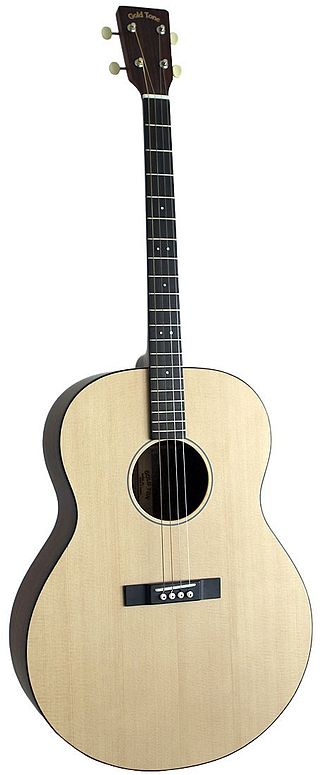
The tenor guitar or four-string guitar is a slightly smaller, four-string relative of the steel-string acoustic guitar or electric guitar. The instrument was initially developed in its acoustic form by Gibson and C.F. Martin so that players of the four-string tenor banjo could double on guitar.
A string band is an old-time music or jazz ensemble made up mainly or solely of string instruments. String bands were popular in the 1920s and 1930s, and are among the forerunners of modern country music and bluegrass. While being active countrywide, in Philadelphia and its surrounding suburbs they are a huge part of its musical culture and traditions, appearing, among others, in the yearly Mummers Parade.
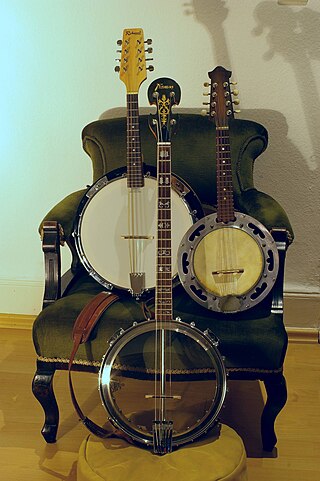
The mandolin-banjo is a hybrid instrument, combining a banjo body with the neck and tuning of a mandolin. It is a soprano banjo. It has been independently invented in more than one country, variously being called mandolin-banjo,banjo-mandolin,banjolin and banjourine in English-speaking countries, banjoline and bandoline in France, and the Cümbüş in Turkey.

Jim & Jesse were an American bluegrass music duo composed of brothers Jim McReynolds and Jesse McReynolds. The two were born and raised in Carfax, a community near Coeburn, Virginia, United States. Their grandfather, Charles McReynolds, had led the band "The Bull Mountain Moonshiners", who recorded at the Bristol Sessions in 1927.
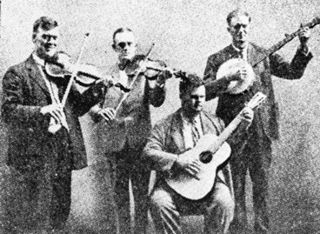
The Skillet Lickers were an old-time band from Georgia, United States.
Joseph Calvin "Butch" Robins is an American five-string–banjo player with his own, distinct style. He's an individualist and, according to himself, "a seeker of information, knowledge and wisdom."
Theron Evan Hale was an American old-time fiddle and banjo player. He was a member of the Grand Ole Opry in the late 1920s and 1930s, and is often remembered as a more laid back and sedate alternative to the raucous dance and "hoedown" music that dominated the Opry in its early days. Hale continued playing and recording until the late 1940s, often accompanied by Opry guitarist Sam McGee.
Sidney Johnson "Fiddlin' Sid" Harkreader was an American Old-time fiddle player and string band leader. He was an early member of the Grand Ole Opry, at first accompanying banjoist Uncle Dave Macon and later performing on the program with his own band. In the 1940s, Harkreader formed and briefly toured with the Western band "The Round-Up Gang" before returning again to the Opry.
The Gully Jumpers were an American Old-time string band originally consisting of bandleader Paul Warmack (1889–1954) on mandolin, Charles Arrington (1893-1960) on fiddle, Burt Hutcherson (1893–1980) on guitar, and William Roy Hardison (1896–1966) on banjo. They were regular performers on the Grand Ole Opry in the late 1920s and are believed to have been the first group to release a record recorded in Nashville, Tennessee. Although their line-up changed over the years, the Gully Jumpers continued performing until the mid-1960s.

Natasha's Waltz is a compilation album of American guitarist Norman Blake, released in 1987. It contains all of the tracks from the vinyl release Original Underground Music from the Mysterious South, along with six tracks from Full Moon on the Farm and two tracks from Rising Fawn String Ensemble. The cover is the same as Original Underground Music from the Mysterious South.

County Records was a Virginia-based independent American record label founded by David Freeman in 1963. The label specialised in old-time and traditional bluegrass music.
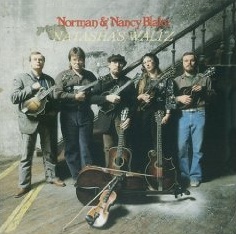
Original Underground Music from the Mysterious South is an album of American guitarist Norman Blake and the Rising Fawn String Ensemble, released in 1982.
Clark Kessinger was an American old-time fiddler. Many of his fiddle tunes made their way to other fiddlers or into the bluegrass music genre.
William G. Evans is an American musician, author, and instructor noted for his banjo proficiency and knowledge of the history of the instrument.

The mandolin has had a place in North American culture since the 1880s, when a "mandolin craze" began. The continent was a land of immigrants, including Italian immigrants, some of whom brought their mandolins with them. In spite of the mandolin having arrived in America, it was not in the cultural consciousness until after 1880 when the Spanish Students arrived on their international performing tour. Afterwards, a "mandolin craze" swept the United States, with large numbers of young people taking up the instrument and teachers such as Samuel Siegel touring the United States. The fad died out after World War I, but enough had learned the instrument that it remained. The mandolin found a new surge with the music of Bill Monroe; the Gibson F-5 mandolin he played, as well as other archtop instruments, became the American standard for mandolins. Bowlback mandolins were displaced. The instrument has been taken up in blues, bluegrass, jug-band music, country, rock, punk and other genres of music. While not as popular as the guitar, it is widespread across the country.
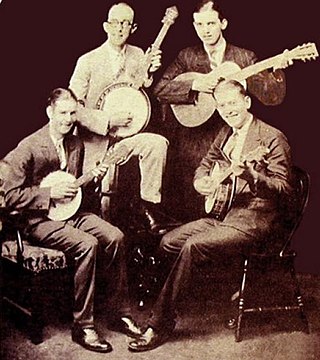
The Tenneva Ramblers were an old-time string band which consisted of singer and guitar player Claude Grant, his mandolin-playing brother Jack Grant, and Jack Pierce.